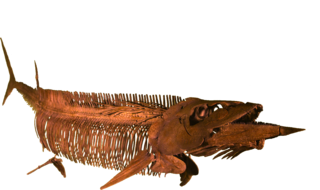Bolodon is a genus of extinct mammal from the Lower Cretaceous of Europe and North America. It was a member of the extinct order of Multituberculata and belongs to the suborder Plagiaulacida and family Plagiaulacidae.

Ornithopsis was a medium-sized Early Cretaceous sauropod dinosaur, from England. The type species, which is the only species seen as valid today, is O. hulkei.

The snaggletooth shark, or fossil shark, is a species of weasel shark in the family Hemigaleidae, and the only extant member of the genus Hemipristis. It is found in the Indo-West Pacific, including the Red Sea, from southeast Africa to the Philippines, north to China, and south to Australia, at depths from 1 to 130 metres. This shark can be found near the bottom of the water column of coastal areas, but can be found at continental and insular shelves. Its length is up to 240 cm (7.87 ft). Despite being only vulnerable to extinction, this shark is very rarely seen.

The lesser spear-nosed bat is a bat species from South America. It is found in Bolivia, Brazil, Colombia, Ecuador, Guyana, Peru, Suriname and Venezuela.

Phyllostomus is a genus of leaf-nosed bat. It contains four described species.

The Del Norte salamander is a species of salamander in the family Plethodontidae endemic to the United States in southwestern Oregon and northwestern California.

Saurodon is an extinct genus of ichthyodectiform fish from the Cretaceous.

Elongatoolithus is an oogenus of dinosaur eggs found in the Late Cretaceous formations of China and Mongolia. Like other elongatoolithids, they were laid by small theropods, and were cared for and incubated by their parents until hatching. They are often found in nests arranged in multiple layers of concentric rings. As its name suggests, Elongatoolithus was a highly elongated form of egg. It is historically significant for being among the first fossil eggs given a parataxonomic name.
Kampimodromus aberrans is a species of mite in the family Phytoseiidae. It is found in Europe.
Kampimodromus adrianae is a species of mite in the family Phytoseiidae.
Kampimodromus alettae is a species of mite in the family Phytoseiidae.
Kampimodromus echii is a species of mite in the family Phytoseiidae.
Kampimodromus ericinus is a species of mite in the family Phytoseiidae.
Kampimodromus hmiminai is a species of mite in the family Phytoseiidae.
Kampimodromus keae is a species of mite in the family Phytoseiidae.
Kampimodromus langei is a species of mite in the family Phytoseiidae. It is found in Europe.
Kampimodromus ragusai is a species of mite in the family Phytoseiidae.

Sebastes elongatus is a species of fish in the rockfish family found in the northeast pacific.

Synechococcus elongatus is a unicellular cyanobacterium that has a rapid autotrophic growth comparable to yeast. Its ability to grow rapidly using sunlight has implications for biotechnological applications, especially when incorporating genetic modification.
Campocraspedon is a genus of ichneumonid wasp in the insect order Hymenoptera. It comprises six species.








